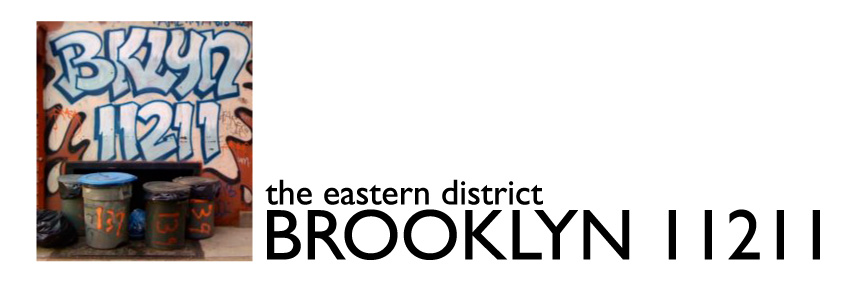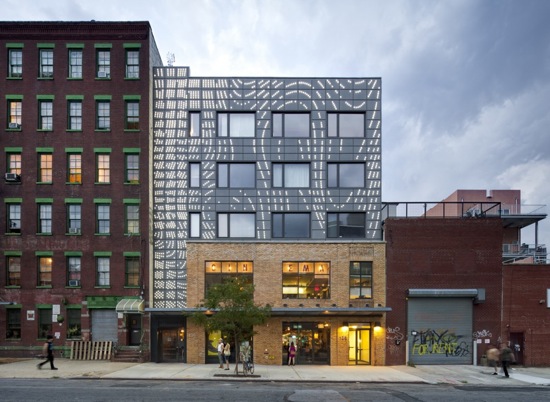Via Animal, Marcos Zotes’ great Nuit Blanche installation.
The Giant Eye Is Watching You, Greenpoint
RIP

Brooklyn Has the Best Pizza in the City
The Daily News reports that Brooklyn has taken the top spot in Zagat’s pizza ranking. The top-rated pizza in the city is Totonno’s. The top five are all outer borough – four in Brooklyn, including Roberta’s, and one on Staten Island. So if you’re looking for decent pizza in Manhattan, check out the list here and skip down to #6.
McCarren is First Brooklyn Park to Get Wifi
Upgrading the L Train
The MTA has announced a series of planned upgrades for service on the L line – moves that, in the long term, at least, could ease some of the overcrowding on the line. The services changes are partially a response to a request from State Senator Dan Squadron that the the MTA review the state of service on the F and L lines, and partially a response to the fact that everyone knew service on the L line was beyond capacity. (Its not just the morning rush, either – as the Times points out, service on the L train is often 35% over capacity on Saturday afternoons.)
Second Avenue Sagas has a nice rundown of all the changes that are planned. The only immediate change is that the MTA will add one additional train in the 9:00 to 9:30 morning rush period. Theoretically, this will lower crowding during this period from the current 101% to something in the mid-90% range (pro-tip – the cars at the back of the train are only running at 99% capacity in the morning rush (vs. 130% at the front) – pile in!) . Long term, the MTA will finally roll out its fully- automated train service (CBTC) on the L line. With the full implementation of the automated service, the MTA says it can run up to 24 trains an hour on the L line (currently, headway is limited to 17 trains an hour).
All of this will – in the long term – help the average commute on the Canarsie line. In the short term however, expect more weekend service cuts, as the MTA continues to implement the switching necessary to get automated service fully online by late 2012. And remember that even with the potential for 24 trains an hour, the line is still only two tracks – if one train gets stuck, everyone behind still has wait for that sick passenger to get off the train. And as new residential developments all up and down the line continue to come on line (there are still about 5,000 unbuilt housing units from the 2005 rezoning alone), those additional 7 trains an hour will pretty soon be running at capacity too.
Nighthawk on ArchDaily
Nighthawk Cinema and Apartments
Caliper Studio, architects
The Nighthawk Cinema building gets a nice feature (and a lot of nice photos) on ArchDaily.
Bike Share Preview
NAG and City DOT are co-sponsoring a Bike Share preview tomorrow afternoon from noon to 4:00 at McCarren Park (North 12th and Bedford). You can check out the Bike Share setup, and even test ride a bike.
Suicide in Park Enforces Need for Local Shelter
The Greenpoint Gazette’s Jeff Mann nails it:
The tragedy strengthened the calls of many Greenpointers to establish a shelter in the neighborhood to deal with its unique homeless population… Greenpoint’s indigenous homeless population consists, for the most part, of Polish speaking, chronic alcoholics. Unfortunately, the Department of Homeless Services (DHS) does not offer a solution for people who need permanent housing, alcohol counseling and a Polish speaking staff. In fact, their alcoholism often disqualifies them from housing, raising fears that the neighborhood could see more fatalities as winter approaches.
The recent suicide in McGolrick Park cruelly emphasizes the crux of the issue over the proposed homeless shelter at 400 McGuinness Boulevard – Greenpoint has a homeless population that needs help, but the help they need would not be available at the homeless shelter that the City wants to put in the neighborhood.
Economic Downturn Breeds Stalled Construction Sites
After commenting earlier today that the number of stalled sites seemed to be dropping quickly, this article appeared in Google alerts:
Williamsburg and Greenpoint saw a pre-recession development boom. Since 2009, approximately half of the city’s stalled sites have been located in these neighborhoods. Currently, 92 sites are inactive in the area, compared to 129 in all of Manhattan.
I’ve always been skeptical of the City’s official count of stalled sites, both in terms of undercounting and overcounting (which means the gross number might be roughly accurate, but the actual site list probably isn’t). It would be interesting to map actual vs. perceived stalled sites and see where the discrepancies lie. Certainly there are still some big ones, like the Domsey site illustrated in the Epoch Times article, the North 4th and Bedford hulk, and the South 4th sites on and near Bedford, but often they have very atypical back stories (epic bankruptcies, construction accidents, lawsuits and the like). But a number of prominent stalled sites are back in construction or nearly so, including 111 Kent, the North 6th and Wythe site (steel is going up) and North 1st and Kent steel skeleton.
Ignoring the Waterfront That We Have
Tom Stoelker in The Architects Newspaper:
Now that Michael Marrella, who guided the massive waterfront plan, Vision 2020, into being last spring, has been bumped up to Director of Waterfront and Open Space Planning Division, he has miles and miles of shoreline to divvy up between two very different users—the public and industry. Charged with both implementing public access to the water for quality of life uses while also supporting a working waterfront, Marella made his position clear: “We’re not looking to relocate or displace industrial uses.”
The article notes that Con Ed is close to a deal with Brooklyn Bridge Park that will allow the Park to acquire a 5-acre site adjacent to the Con Ed plant in Dumbo. No mention is made of the two Con Ed-owned locations in Williamsburg – the transformer station to the south of 184 Kent and the former BRT power plan site just south of Division. Also not mentioned is why the City doesn’t development the parkland it has already created at Bushwick Inlet and along the Greenpoint waterfront, or why they City doesn’t develop land it already owns (and does not use for industrial purposes) like that at “Williamsburg Bridge Park”.

